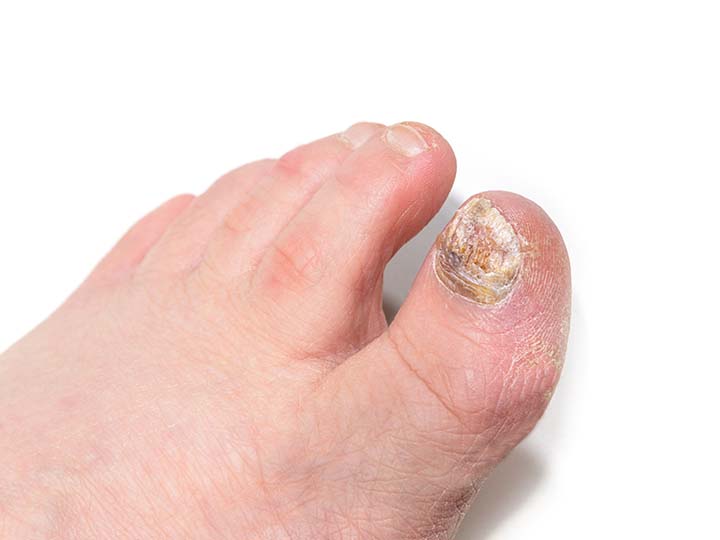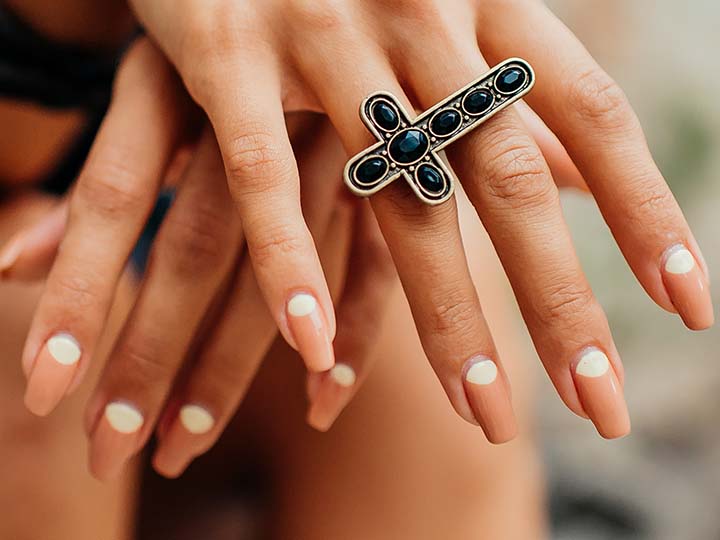Worried About a Green Nail?
Have you recently noticed one of your nails turning green? It’s an alarming sight, and naturally, you’re left asking, why is my nail green? Whether it’s a small spot or your whole nail has taken on a greenish hue, it can be unsettling, to say the least.
But don’t panic—this condition is more common than you think and is often treatable. The green discoloration is typically caused by bacteria, particularly a type called Pseudomonas, which thrives in moist environments. Let's explore the causes behind green nails, what they mean, and the steps you can take to get your nails back to their healthy, natural color.
Why Is My Nail Green? Common Causes
There are a few common reasons why you might see green discoloration on your nails. Understanding these causes can help you address the issue effectively.
1. Bacterial Infection (Pseudomonas)
The most common cause of green nails is a bacterial infection caused by Pseudomonas aeruginosa. This bacteria thrives in moist environments, like under fake nails, between the natural nail and nail enhancements, or under a chipped nail. When Pseudomonas gets trapped in these spaces, it produces a green pigment that stains the nail plate.
- How it happens: If water or moisture gets trapped under acrylics, gels, or other nail enhancements, it creates an ideal environment for bacteria to grow. This can also occur under natural nails if they’re damaged or if you constantly expose them to wet environments.
2. Water Trapped Under Artificial Nails
If you frequently wear acrylic or gel nails, water can easily get trapped between the enhancement and your natural nail. When moisture is sealed in this way, bacteria like Pseudomonas can thrive, leading to the tell-tale greenish stain.
- How it happens: Improper application of nail enhancements or cracks in the nails can allow water to get trapped. If the artificial nails lift even slightly, bacteria can seep in and start to multiply.
3. Nail Trauma
A less common cause of green nails can be trauma or damage to the nail bed. When the nail is injured, it’s more susceptible to infection. The area becomes a breeding ground for bacteria, especially if it’s exposed to moisture or debris.
- How it happens: Trauma can occur from hitting or bending your nail, causing small separations between the nail plate and nail bed. This opens the door to bacteria entering and causing infection.
4. Fungal Infections
Though less likely to cause green nails, fungal infections can sometimes lead to green or discolored nails. Fungal infections usually cause thickened, yellowish nails, but in some cases, they may contribute to a green tint when mixed with bacterial infections.
- How it happens: Prolonged moisture exposure or poor hygiene can result in fungal infections, which may cause discoloration if not treated early.
How to Treat Green Nails: Solutions to Fix the Problem
So, you’ve noticed your nail has turned green—what now? Luckily, green nails can often be treated effectively with simple home remedies or medical treatments, depending on the severity.
1. Remove Artificial Nails
If you’re wearing acrylics or gel nails and notice green discoloration underneath, the first step is to remove the artificial nails. This allows your natural nail to breathe and stops moisture from being trapped, which is key to preventing further bacterial growth.
- Tip: Let your natural nails grow out without enhancements for a few weeks to give them time to heal and regain their strength.
2. Disinfect the Affected Area
Once the artificial nails are removed, it’s important to clean and disinfect the affected nail. You can use an antibacterial or antiseptic solution like rubbing alcohol or hydrogen peroxide to gently clean the nail plate and surrounding skin.
- How to do it: Dip a cotton pad in rubbing alcohol or hydrogen peroxide and wipe the nail surface to kill any bacteria. Repeat this process daily until the green discoloration fades.
3. Apply Antibacterial Treatments
In more severe cases, an over-the-counter antibacterial ointment may be necessary to treat the infection. These topical treatments can help eliminate the bacteria causing the green nail and speed up the healing process.
- Tip: Look for products containing ingredients like polymyxin B or bacitracin, which are effective against bacterial infections.
4. Trim and Maintain Your Nails
Keep your nails trimmed and well-maintained to reduce the risk of further infections. Avoid long nails that can trap dirt and bacteria, and make sure to file any rough edges to prevent trauma or snagging.
- Tip: Use clean, disinfected tools whenever trimming or filing your nails to prevent bacteria from spreading.
5. See a Doctor If It Doesn’t Improve
If the green ddiscolorationdoesn’t improve after a few days of home treatment, or if you notice signs of worsening infection (like pain, swelling, or pus), it’s time to see a healthcare professional. A doctor may prescribe a stronger antibacterial treatment or identify any underlying issues contributing to the infection.
How to Prevent Green Nails: Tips for Nail Health
Preventing green nails is all about proper nail care and hygiene. Here are a few tips to keep your nails healthy and avoid future infections:
1. Dry Your Nails Thoroughly
Moisture is the main culprit behind Pseudomonas infections, so make sure to dry your hands and nails thoroughly after washing them. Pay special attention to the area under your nails, as this is where bacteria can easily hide.
2. Use Proper Nail Enhancement Techniques
If you love wearing acrylics or gels, it’s important to ensure they’re applied correctly. Avoid overly thick layers of acrylic, as these can trap moisture more easily. Always go to a reputable nail technician who follows proper hygiene protocols.
- Tip: If you notice any lifting or cracks in your artificial nails, address them immediately to avoid water and bacteria getting trapped.
3. Take Breaks from Artificial Nails
Constantly wearing acrylic or gel nails can weaken your natural nails and make them more prone to infections. Take breaks between applications to let your natural nails breathe and recover.
4. Avoid Nail Trauma
Be mindful of your nails when doing daily activities, especially if you’re prone to nail trauma. Wearing gloves when working with your hands can help protect your nails from injury.
Wrapping It Up
So, why is my nail green? The green discoloration is most often caused by a bacterial infection, particularly Pseudomonas, which thrives in moist environments. While the sight of a green nail can be concerning, it’s usually treatable with proper care, including removing artificial nails, disinfecting the area, and applying antibacterial treatments.
By maintaining good nail hygiene and taking preventive measures, you can avoid green nails in the future and keep your nails healthy and strong!
Achieve flawless beauty effortlessly. Explore Mersi for your perfect look!
FAQs
Q1: Can green nails go away on their own?
In mild cases, green nails caused by Pseudomonas infections may fade on their own once the moisture source is removed. However, it’s always best to treat the infection with antibacterial products to prevent it from worsening.
Q2: Should I be worried if my nail is green?
While green nails can be alarming, they’re usually caused by a bacterial infection that’s treatable with proper care. If you notice persistent green discoloration or signs of a severe infection, consult a doctor.
Q3: Can I still wear acrylics if my nails have turned green?
No, it’s important to remove any artificial nails if you notice green discoloration. Give your natural nails time to heal before applying acrylics again to avoid worsening the infection.
Q4: How long does it take for green nails to heal?
With proper treatment, most green nails will begin to clear up within a week or two. In more severe cases, it may take longer, especially if the nail is damaged or weakened.
Q5: How can I prevent green nails in the future?
To prevent green nails, keep your nails clean and dry, ensure your artificial nails are applied correctly, and take regular breaks from nail enhancements to allow your natural nails to recover.





Leave a comment
This site is protected by hCaptcha and the hCaptcha Privacy Policy and Terms of Service apply.